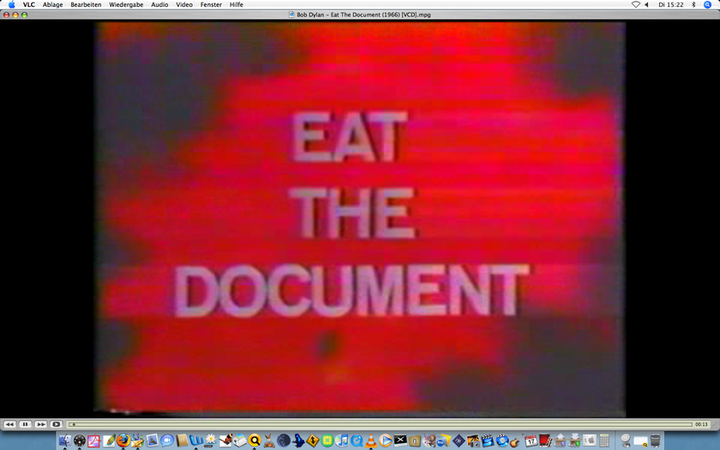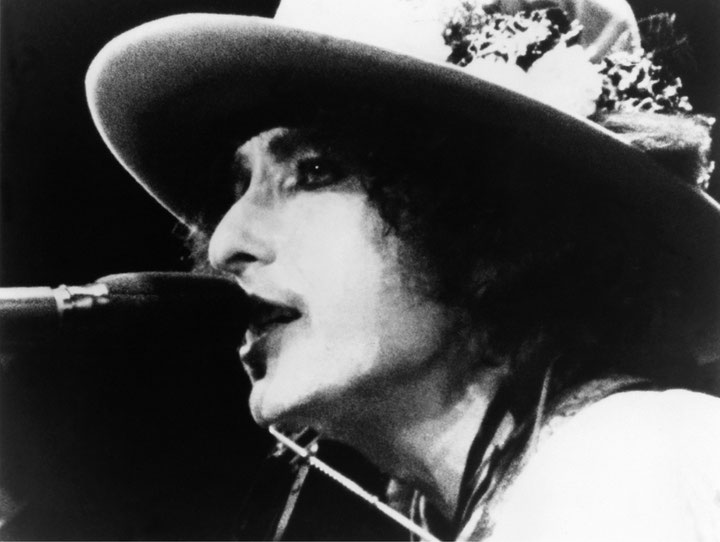»The movie to me is more a painting than music. It is a painting. It’s a painting coming alive off a wall.«1 Bob Dylan had quite some explaining to do in 1978 to justify »Renaldo & Clara,« his four-hour-long film that was later almost unanimously blasted by the critics. For years, he hadn’t given any interviews; he was primarily visible only in his musician’s masks, or, as in the film »Pat Garrett hunts Billy the Kid,« in the role of the silent »Alias.« But now, after completing his cinematic magnum opus, a work that was as little understood as his choice of the electric guitar in 1965 or his almost complete retreat from the public in the second half of the 1960s, he began to speak out again in his well-known manner, at the same time clarifying and complicating. »It’s about the essence of man being alienated from himself and how, in order to free himself, to be reborn, he has to go outside himself.«2 Little wonder that his explanations led to more questions, which in turn led to even more erratic answers or minor sophisms that surprised even the most hard-nosed listeners: was Bob Dylan himself in the film? »It would be silly. Did you ever see a Picasso painting with Picasso in the picture?«3
The painting metaphors Dylan employed to make his film more palatable – three years in the making, but gone from the movie theaters in a flash in 1978 – can be regarded at the same time as illuminating and misleading. Illuminating because he was intent on creating an art form that could be found beyond the mere music oeuvre, the increasingly irksome »The Man and his Music« business. Of course, the music was still the central focus, especially the concerts of the 1975 Rolling Thunder Revue, which resembled a conniving traveling circus more that the bombastic shows that prevailed at the time.4 The fact that Dylan first presented himself wearing an acrylic glass mask, then later with his face painted white, implies that any biographic references whatsoever were being exaggerated ad absurdum. In the film, Dylan took on the role of Renaldo, musician Ronnie Hawkins played Bob Dylan, his then-wife Sara played Clara, and so on. »The persona of Bob Dylan is in the movie so we could get rid of it. […] …Nobody’s hiding anything. […] The rabbits are falling out of the hat before the movie begins,«5 he explains in an interview. The fact that this new art form – you could call it an art-music film painted in thick, pasty layers – unswervingly confused the domains of actor and role,6 even continuously »painted over« the one with the other, may be one of the features worth seeing the most in a film that was long dismissed. What is perhaps »Renaldo & Clara’s« most lasting contribution to film history is the use of many small narrative plot lines, the artistic acts taking place on the side, set on different time levels surrounding the Rolling Thunder Revue, which create a multi-focal de-centralized tableau. Programmatically, Renaldo/Dylan sings at the start »When I Paint My Masterpiece,« and at the end we see an anonymous soul singer intone a ballad about »The Morning of My Life« as if to underline »that Renaldo may have been dreaming.«7
But it is also misleading to regard the film as too picturesque, tightly woven as it is with colors, planes and figures. It is too heavy on sound, too literary – for instance in the scenes with Allen Ginsberg – and appears too embellished with minority policies in the parts about Black and Indigenous America. On the other hand, that is what sets »Renaldo & Clara« apart from the art-music film that was popular at the time. Dylan himself said it was about setting straight the mess D. A. Pennebaker had made with the direct-cinema portrait »Don’t Look Back.« »That movie was done by a man who took it all out of context …The movie was dishonest, it was a propaganda movie,«8 commented Dylan, who was horrified when he saw the film and immediately came up with a kind of revenge project. Pennebaker and his cameraman Howard Alk were to accompany him again on the notorious »Judas Tour« in England in 1966, and here Dylan reserved the right to assist in the final cut. Again, Pennebaker produced his version – »Something Is Happening Here« – which was never aired although some of the material appeared 40 years later in Martin Scorsese’s homage to Dylan, »No Direction Home« – and again, Dylan wanted to take into his own hands the means of portrayal. He had always mistrusted the ideology of the documentary – as if it were so easy to create an image resembling reality9 –, but in his own version, he went a step further. »Eat The Document,« the title of the film he re-cut several times over the years, was finally shown once (1972) on TV in the US, and it offered a deliberate contrast to chronotopically ordered verism à la Pennebaker. The documentary material was intended to – in time warps, repetitions and breaks – devour itself. Do away with the idea that a pop singer’s tour and life on and behind stage could be reduced to a linear narrative, bit by bit, song by song.
From a present-day perspective, »Eat The Document’s« value lies in just that skepticism toward an all too naive documentarism; it offers leaps and detours that hardly seem to fit into a common thematic framework. It is interspersed with excerpts of Dylan’s electrifying performances in the spring of 1966 (with a level of energy that he didn’t reach again until the Rolling Thunder Revue, and never again afterwards). But they leave off abruptly as the viewer is unwittingly confronted with short insertions, for instance when band member Richard Manuel wants to trade his leather jacket for a shy teenager’s girlfriend. Or when Dylan and John Lennon are chauffeured around in a limousine, and he is almost at the point where he is going to give the camera his all, that is throw up. Borderline moments like these, moments that take to new heights the indecisiveness between the documentary, the inartificial on one hand and the scripted, acted-out aspect on the other, clearly inspired Todd Haynes’ version of a Dylan film, »I’m Not There.« While here everything appears to be slightly exaggerated, above all the formidable array of figures, it is just this prismatic refraction that allows a glance at contradictions, at inconsistencies and synchronies that only slightly overlap. It’s as if the many configurations of one and the same artificial figure were meeting up and competing against each other– »Eat The Fiction,« as it were.
Dylan’s own way out of the straits and deficits of the factographical was, similar to the route Neil Young took in his first film, »Journey Through The Past« (1972), to clearly undercut any kind of biographical certainty. Thus, Dylan becomes Renaldo, standing on a stage and singing songs by Bob Dylan, who is someone else in the film, whereas this could also be a mix-up (the first scene with Hawkins as Dylan suggests as much). This entire carnivalesque transfiguration, this aimless becoming, is only designed to make sure that in the end no one can say any longer which one really is Bob Dylan. Although nominally he is still mentioned as the director of the film and as the songwriter of most of the music in the film, a fact that finally let the biographical trap surrounding »Renaldo & Clara« snap shut again, since hardly a soul knew what to do with the bewildering and depersonalizing game once you could not hold the main protagonist responsible. That again led to extreme reductions – that this was about the split between Dylan and his wife Sara, whom he divorced in 1977, or about a songwriter on the decline trying to re-invent himself in a different medium (film), which of course has to result in artificiality and pretension.
It was to take all of 25 years until Dylan – apart from a few negligible bit parts – returned to making films. As screenplay author Sergej Petrov and film character Jack Fate, he left his mark on »Masked and Anonymous« (2003), again a film that was not easy to decipher. The jailed musician Fate is let out of prison to play a charity concert in a country embroiled in civil war. He is confronted with scheming manipulation in the entertainment industry and the media and in the end lands in prison again for a murder he did not commit. Anyone choosing to regard this as an allegory on Dylan’s life since »Renaldo & Clara« was not totally wrong, but also did not necessarily get any closer to the nervous dystopia the film exhibits. The »old weird America« that Dylan left so much room for in his music had all of a sudden turned into an all too familiar horror vision. The accomplished eloquence behind the masks that marked »Renaldo & Clara« had made way for an ominous obduracy. Anonymity was the fate of this particular kind of, by now marginal, art-music film.
The film series »A Tribute to Bob Dylan« was shown October 17 – 29, 2008 during the VIENNALE; http://www.viennale.at.
Translated by Jennifer Taylor-Gaida
1 Interview with Ron Rosenbaum, in: Playboy, March 1978, reprinted in: Jonathan Cott (ed.), Dylan On Dylan: The Essential Interviews. London 2007, p. 214.
2 ibid., p. 217.
3 ibid., p. 219.
4 Cf. Sam Shepard, The Rolling Thunder Logbook. New York 2004 [Original 1977], Larry Sloman, »Essay on Bob Dylan,« The Bootleg Series, Vol. 5: The Rolling Thunder Revue. Columbia/Legacy 2002, and Clinton Heylin, Bob Dylan: Behind the Shades Revisited. New York 2003, p. 413 ff.
5 Interview with Ron Rosenbaum, p. 219.
6 Cf. Diedrich Diederichsen, Eigenblutdoping. Cologne 2008, p. 95 ff.
7 Interview with Jonathan Cott, in: Rolling Stone, January 26, 1978, reprinted in: Dylan on Dylan, p. 185.
8 Interview with Ron Rosenbaum, p. 214.
9 Cf. Cyril Neyrat, »Masked and Anonymous: Bob Dylan’s Life With Movies,« in: VIENNALE 2008, Catalogue. Vienna 2008, p. 279 ff.

